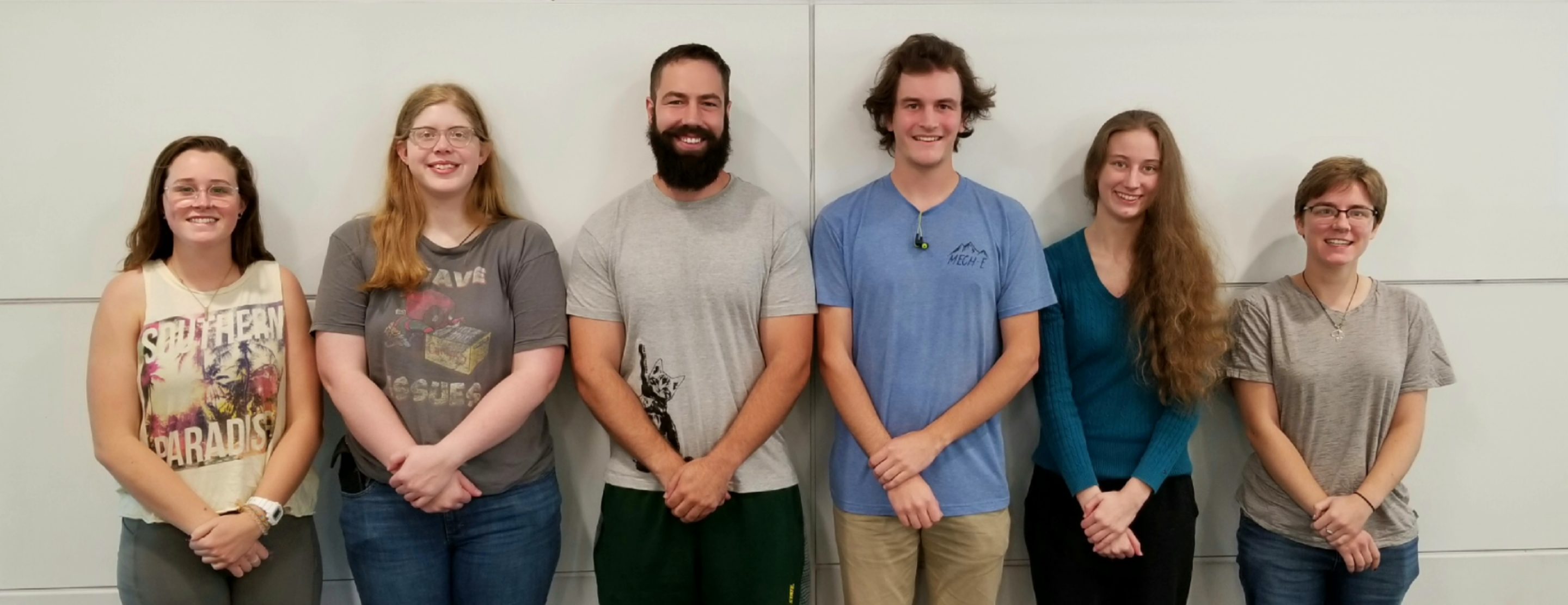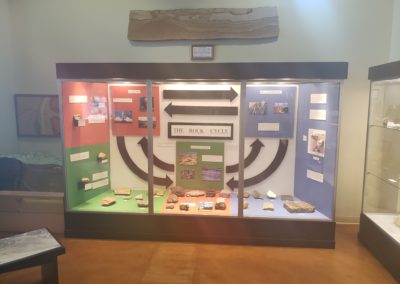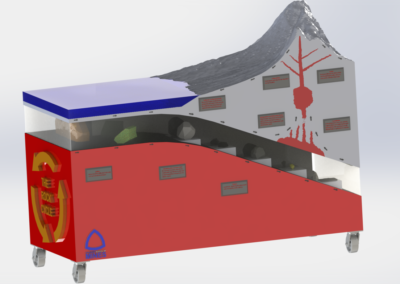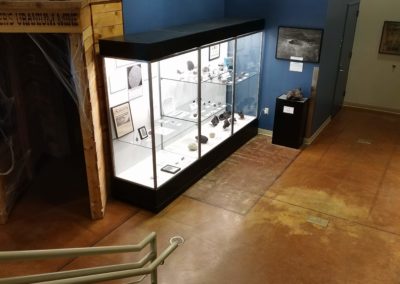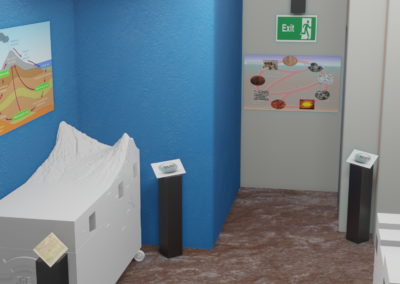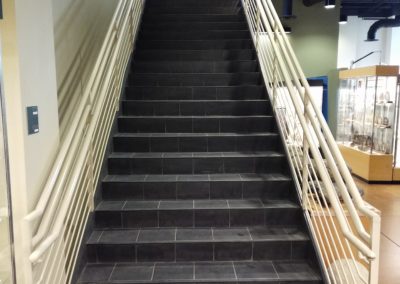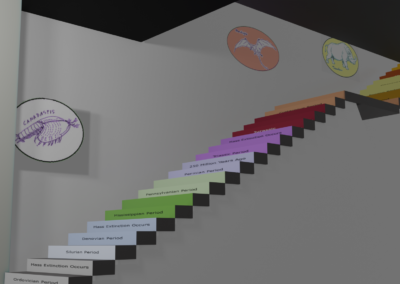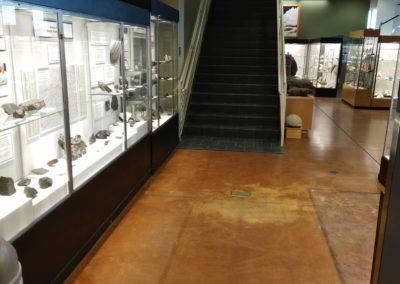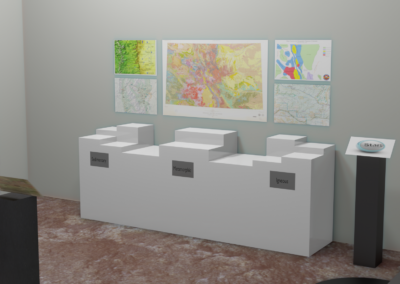We were tasked with the redesign of the rock cycle exhibit in the Mines Geology Museum...
Project Synopsis
Overview
The Colorado School of Mines Geology Museum’s current exhibit on the Rock Cycle is due for an update. The management requested our team to present them with design solutions for a larger, updated space in the museum. This design of a new exhibit needs to be engaging and safe for all visitors, from elementary children to geology experts and also highlight Colorado’s unique geology. The cost, construction, and integration should be both reasonable and feasible. The clients include: Renata Lafler (Executive Director), Daniel Schlegel (Operations Director), and Ed Raines (Curator).
Design Approach
The team went through several rounds of brainstorming and refinement to come up with our solution. Our refinements were largely driven by client feedback, as well as the team’s research. We did an initial round of brainstorming, followed by more research and a museum tour, after which we did a second round of brainstorming.
The first round of brainstorming involved throwing any and all ideas out there. We then made a decision matrix to determine which of these ideas would make the best exhibit pieces, placing the most weight on concepts that displayed relevant information, promoted interactivity, and appealed to the interests of a wide range of audiences. These ideas contained, among others, a peg board rock journey; 3-D model that illustrates the rock cycle; large labeled rock specimens that visitors can touch and interact with; extra screens, specifically touch screens, to display additional information to visitors. See Figure 1. The decision matrix can be seen in Figure 2.
The clients picked the best of our concepts, and we began a second round of brainstorming. The clients then came up with several new concepts they wanted incorporated into the exhibit, including a projector to fill the dead space on the far wall of the exhibit near the exits. They advised the use of elements that could withstand misuse from patrons, as they have observed children and adults alike displaying behaviors that are likely to damage exhibits. The team was also advised to make sure that there was plenty of space near interactive parts of the exhibit so as to not cause choke points where people are blocking people from accessing other parts of the museum. Finally, the client advised that patrons were more likely to engage with exhibits if they could interact with or relate to it. Exhibits that allow for interactivity (with a consideration for accessibility for children and persons with disabilities) were encouraged, as well as anything related to Colorado geology.
With these updated guidelines, the team entered a period of revision which focused on refining the existing design ideas from team members and client suggestions. In this stage of design, the team entirely eliminated several proposed options, combined some existing options into a single element, revised and refined others, and developed and incorporated the clients’ idea to use a projector. At the end of this stage, the team had developed a design for an exhibit with five major elements, which are detailed in the “Design Solution” section below. These elements were modeled in various CAD programs and presented to the clients, then the designs went through a final round of revisions and fine-tuning. This last stage of design was also where the team solidified what companies would be best suited for construction of the design. After the design was finalized and the proposed contractors were identified, the team presented the final design to the client alongside the suggested list of next steps needed to turn the exhibit design into a reality.
Figure 1: Brainstorming and concept images (Click Here), Figure 2: Original Decision Matrix (Click Here)
Design Solution
Our team designed a unique exhibit with five main pieces: A Geological Map, Timescale Stairs, Video Projector, 3-D Model Illustrating Rock Cycle, Rock Journey Interactive Game (see image gallery for final designs).
The Geological Map is a large map of Colorado with important geologic formations marked and described. There will also be interactive rock samples below the map from some of the highlighted formations and other rocks that can be found in Colorado.
The existing staircase will be redecorated into the Timescale Stairs. The front of each step will have a sticker corresponding to a different period of earth’s geologic history. Each period will be a different color and the number of steps used will represent the period length. The wall next to the stairs will have images of organisms that lived in each period.
For the Projector, the wall across from the stairs will have a slideshow projected on it. Visitors will see this slideshow as they come down the stairs and while they are in the exhibit space. The projector will show slideshows related to the rock cycle. There will be buttons on a wall near the projector so visitors can change between slideshows.
The 3-D Model Illustrating the Rock Cycle has a self-explanatory name. It is a cross-section of an area illustrating all parts of the rock cycle. It will include a cubby to display rock samples of igneous, metamorphic, and sedimentary rocks. On either side of the model there will be a touch screen that will display additional information about the rock cycle and the exhibit’s rocks samples. The large screen behind the model mirrors one touchscreen kiosk display, allowing a large group of people to view the screen simultaneously.
The Rock Journey Interactive Game will be on a touchscreen tablet placed near the Geologic Map. This piece will have visitors either scan a Rock Ticket or select a ticket on the screen to tell them what rock they are, which will bring up an image and a fun fact.
The combination of these subsystems meets all of the clients’ exhibit criteria. By providing multiple channels to convey information, multiple target groups can understand the important content, it makes the exhibit more engaging and accessible for a wide range of visitors. All exhibits allow for guests to engage with the material through tactile and/or observational methods. Several of the features directly correlate to Colorado geology, allowing visitors to personally connect with the information. Additionally, all exhibits which use technology will also still be at least partially functional if the devices fail or (in the case of the projector) will not be a distraction if it has to be turned off due to failure.
These new pieces update the look of the exhibit, creating a more professional image for the museum. The construction of these designs includes the use of 3D printers, contract artists, museum personnel, and other various contract companies.
Figure 3: Final Designs (Click Here), Table 1: Design Solutions (Click Here)
Next Steps
After the COVID-19 stay-at-home order has been rescinded, private contractors for fabrication should be contacted in order to accurately gauge the pricing options available for subsystem construction. Contact could be made with the Mine’s Computer Science department to officially lay down the groundwork to have students integrate wall-mounted buttons with the projector and/or create interactive software for the touch-screen subsystem. Contact with department heads to see if the proposed manufacturing and 3D printing would be better handled by a Senior Design group, a group of Manufacturing Engineering students, or another department altogether. The current Senior Design staff has mentioned an effort to make unspent funds available to the clients to use for fabrication. This information will be passed along to the clients as it evolves.
Any team continuing the work done by this one should provide the clients with a couple of 3D printed parts. There was expressed interest in seeing the resolution capabilities of 3D printers as they could be used for animal-art on the timescale wall and will be used in the 3D Rock Cycle Exhibit. Parts could be printed in whole or in pieces shaped to fit together. Sanding and painting should be applied to display the final appearance of their potential exhibit piece.
Acknowledgements
This project would not have been possible without our Project Advisor, Mike Yost, and our clients, Renata Lafler, Daniel Schlegel and Ed Raines, whose excellent communication and effort were key in making this project a success. For everything you have done, our team thanks you. Additional thanks goes out to Alexis Sitchler from the Colorado School of Mines Geology Department for assisting as a technical professional and to Steve Francis for acting as a Risk Management advisor.
Before and After of Exhibits
.
